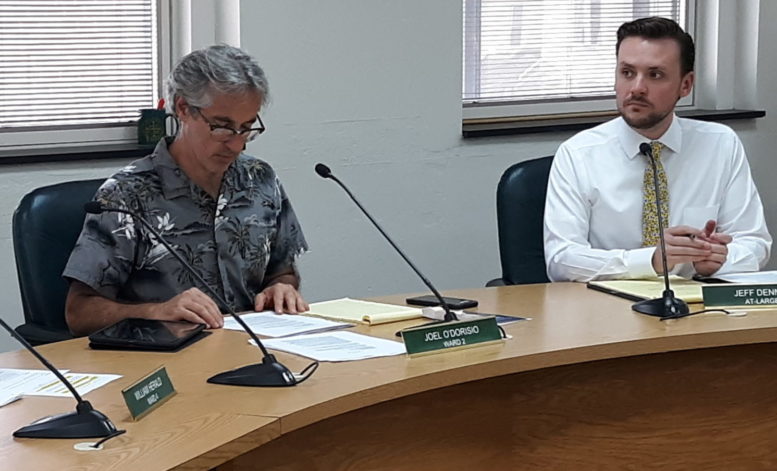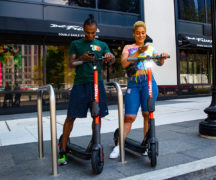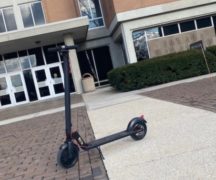By JAN LARSON McLAUGHLIN
BG Independent News
City Council members took steps Monday to make sure Bowling Green won’t be overpopulated by electric scooters and other “micro-mobility” vehicles.
The Community Improvement Committee of City Council met to discuss proposed amendments to the city’s proposed legislation for e-scooters. The recommendations of the committee will go before City Council at its Aug. 15 meeting, when the e-scooter legislation comes off the table.
The committee – made up of Joel O’Dorisio, Jeff Dennis and Bill Herald – discussed three possible amendments to legislation:
- They approved expanding the definition of “micro-mobility devices” to include bicycles, electric bicycles, scooters and electric scooters distributed by companies throughout the city to be rented per trip.
- They agreed with City Attorney Mike Marsh that any data reporting requirements from micro-mobility companies be addressed in the permit process. The type of data required may include: Users by gender and age; number of vehicles in circulation; daily, weekly and monthly active users; small vehicle usage including user miles and duration of rides; heat maps showing routes, trends, origins and destinations; customer comments and complaints; and reported collisions.
- They voted to establish fleet size requirements that set a maximum number of scooters and bicycles per business.
The committee suggested that each micro-mobility business operating in the city be limited to 100 scooters, 100 bicycles, or 150 for a combination of scooters and bikes. They also voted to set a maximum fleet of 500 units in the city.
“I would worry about having more than 500 of these on the streets,” Dennis said.
Herald suggested it might make sense to let the market set the limits.
However, O’Dorosio said it’s important that a balance be struck for the community.
“There’s already going to be conflicts with traffic,” O’Dorisio said.
The local legislation allows the city to make specific rules for Bowling Green. The state of Ohio has passed legislation allowing the use of electric scooters and authorizing local jurisdictions to pass additional regulations as they see fit – otherwise the state law governs.
City staff has studied the Bowling Green State University policy on e-scooters, as well as legislation adopted in other Ohio cities. The goal is “to ensure that such mobility sharing systems are consistent with the safety and well-being of the citizens of Bowling Green.”
Electric scooters will be considered vehicular traffic – like cars and bicycles – which are not to be operated on sidewalks. The exceptions will allow the scooters to be parked on sidewalks, and will allow them to be operated on sidewalks permitted at BGSU.
The legislation requires that the scooters come with a forward pointed lamp, a back reflector, and lists the following operating rules:
- Cannot be operated on sidewalks, except as permitted by BGSU.
- Cannot be operated on streets or highways with speed limits higher than 35 mph.
- Cannot exceed 20 mph.
- Riders must be at least 18 years old.
Based on experiences in other communities, Bowling Green’s legislation establishes parking regulations so that the scooters do not impede ADA accessibility.
Following are some provisions of the proposed e-scooter ordinance:
- Any business seeking to operate a shared electric scooter program within the city shall first enter into an agreement with the city.
- Providers shall provide easily visible contact information, including toll-free phone number and email address on each scooter for city employees and the public to report problems.
- The city reserves the right to terminate the “use agreement” for cause or woefully negligent practices.
- Providers will take reasonable steps to ensure that all riders understand the requirements of ADA accessibility and the importance of leaving ADA paths of travel clear and accessible.
- Providers may stage e-scooters in permitted parking areas. If a provider wants to stage in areas other than the public right-of-way, permission must be obtained from the city, property owner or public agency.
- Providers must adhere to all indemnification and insurance requirements.
The ordinance also outlines some restrictions for operating the e-scooters.
- No more than one rider will be allowed at a time.
- Riders must not carry items that require both hands.
- The scooters may be operated on shared bicycle/pedestrian ways, including on shared pathways in public parks and streets. Anyone riding an e-scooter on a bicycle/pedestrian pathway, and is approaching a pedestrian, should give an audible warning and yield to the pedestrian – dismounting if necessary.
- E-scooters are to stay on the right of street lanes, and offer the right of way to bicycles in bike lanes.
Parking requirements:
- Riders of e-scooters should park the devices upright on hard surfaces on the curb of the sidewalk, beside a bike rack, or in another area specifically designated for bicycle parking, or on the street next to an unmarked curb.
- Riders should not park scooters in such a manner as to block the pedestrian clear zone area of the sidewalk, or ADA paths of travel.
- Riders should not park the scooters where they interfere with the reasonable use of a commercial window display, or access to any building entrance.
- Riders may park e-scooters in on-street parking spaces in the following circumstances – when designated for scooters, where the curb is less than 3 feet wide, in neighborhoods with rolled curbs or inadequate sidewalk space, and in marked parking spaces designated for motorcycles.



